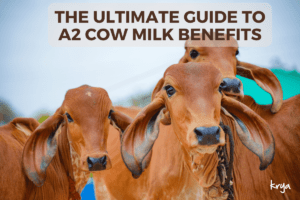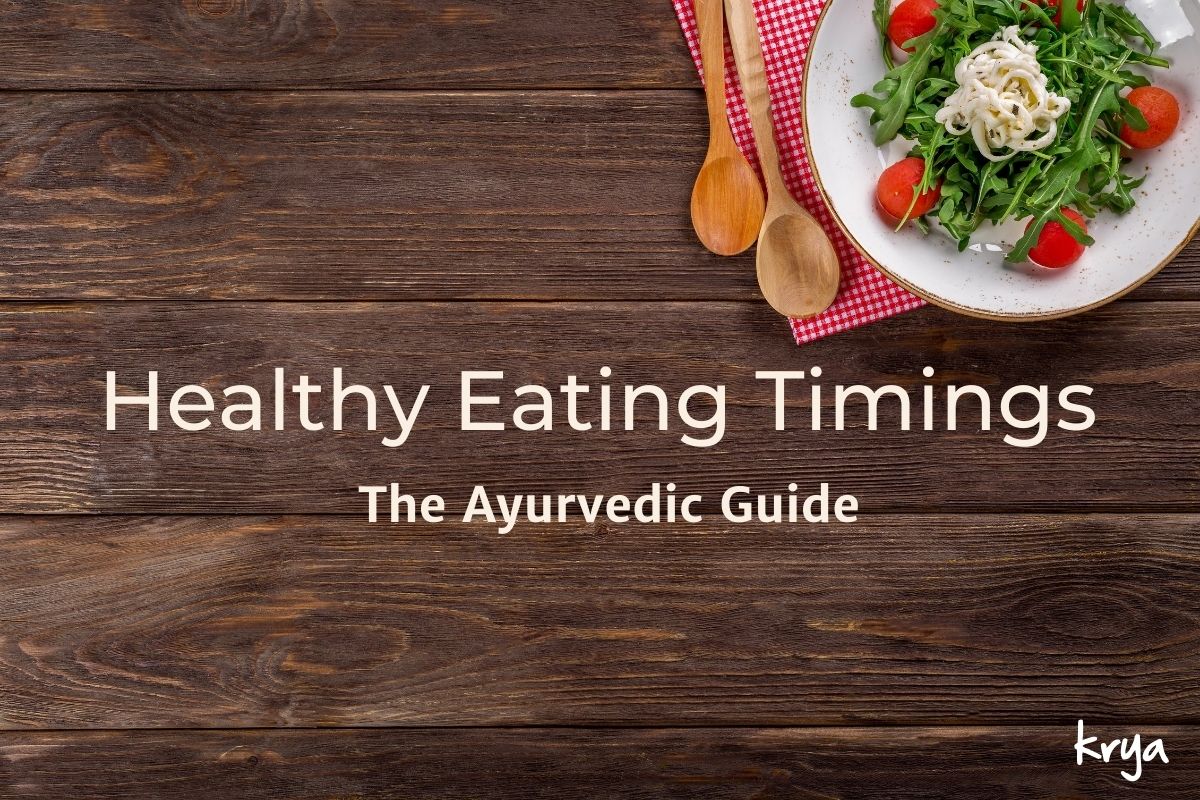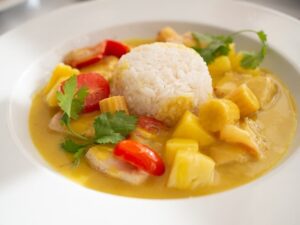This post was last updated on August 12, 2021 by Preethi Sukumaran
As we had written in Part 1, , many Ayurvedic rules on eating for good health, do not go with modern notions on health and nutrition. In fact, they seem contrarian and sometimes weird or even “unscientific” as per modern and often western expectations.
However, as I have always maintained, good health reflects in great skin and hair. At krya we get many queries every day on tackling skin & hair care problems, which cannot be solved with the just use of external products alone, so we do end up gently nudging people to take a second look at their diet and lifestyle.
So here is part 2 of my post on eating sensibly according to Ayurveda. As with all new information, please read this with an open mind.
IMPORTANT NOTE :This article does NOT discuss the ethical consideration behind these food choices as some of the Ayurvedic prescriptions use animal derived products. At this point of time, I am simply talking about how Ayurveda analyzes each food choice in terms of its dosha and how it would impact human health alone.
1. Ayurveda follows a holistic approach to eating. There is no measurement of micro nutrients or break up of food into the terms we measure today like protein, carbohydrates, vitamins, minerals etc.
Instead, Ayurveda and all traditional medicine talks about eating a balanced meal. And is concerned about eating local and seasonal food that is right for each dosha type. This cannot be compressed into a simple diet chart but has to be worked out according to the needs of the individual, their current state of health and the environment they live in and the nature of their work, etc.
So for example, the diet prescribed for me, a Pitta-kapha type would consist of foods that are cooling but do not cause mucous. So if I am prescribed milk, I would be asked to have it unsweetened. Milk is considered as “Madura rasa (sweet taste)” which means it is already high in kapha qualities. As milk calms pitta but can also increase kapha – I might also be asked to drink with a pinch of turmeric, and drunk warm to ensure that my dosha is not aggravated. I would also be asked to have only native cow’s milk and not buffalo milk, as cow’s milk is lighter and does not have the quality of tamas that buffalo milk has .
I might also be asked to cut down completely on consuming jaggery and sesame if my pitta dosha is aggravated or during summer . Both increase pitta, and would perhaps not be ideal for me to eat given my constitution. I would also be asked to include shitali pranayama as part of a yoga practise to cool down my body.
Someone with a high kapha dosha, who often gets mucous filled coughs and colds, would be asked to cut down dairy completely. They would also be asked to cut down sweets, perhaps eat millets for a meal instead of rice, and do brisk exercising or surya namaskar to melt excess kapha in the body and encourage its release.
2. Ayurveda and many new lifestyle diets or ethical diets do not go together. So there is no Vegan Ayurveda. Or Gluten free Ayurveda. Or Paleo Ayurveda. Or Grain free Ayurveda.
Ayurveda prescribes the use of limited quantities of dairy products for good health. This is non negotiable among 3 classes of people: children, people above 60 and pregnant women. For everyone who falls in between, certain kinds of dairy can be avoided as long as they are in good health. Ghee appears to be universally prescribed for everyone as it is considered extremely good for the body and useful to bring down both vitiated pitta and vata.
Many Ayurvedic medicines are made using ghee, honey and sometimes curd and even bone marrow. Each medicine has been formulated keeping the health condition in mind and depending upon what medium will deliver the medicine fastest to the patient.
In certain conditions like vitiated vata, ghee is used extensively to quickly bring down vitiated vata. Every fat is treated separately in Ayurveda, and the qualities of taila, ghrita and majja (oils, ghee, bone marrow) have been extensively documented. In cases where ghee is required, it is cannot be substituted with a vegetable oil, even with coconut oil.
In cases of extreme emaciation, the text books recommend giving very weak, debilated patients mamsa rasa (meat soup) to quickly build up strength. I have seen documented evidence of this treatment working, and working well.
Again here, Ayurveda does not treat plant protein and animal protein as the same. Both are said to have different qualities and are used in different situations. For example, plant protein like lentils is considered as high in vata. So in cases where patients are suffering from vata vitiation driven weakness and emaciation, animal fat like ghee or in extreme cases animal soup (which is considered higher in kapha) is given to build strength.
3. Raw food, is considered as difficult to digest and is considered as stressful to the digestive system. Also, raw food is considered extremely high in vata, and the quality of the food changes depending upon how it is cooked.
So foods already high in vata like cabbage, cauliflower, millets, bread, cornflakes must be eaten only after their basic nature is tempered by the way we prepare them. The texts suggest that these foods should not be eaten raw, and should be cooked in fats like ghee or coconut oil, and must be eaten warm and not cold to bring down their vata increasing effect. Spices like turmeric and jeera should be added to make it easy for the body to digest them. And they should be eaten at peak digestive capacity which is during noon and not after sunset.
For this reason, if your vata dosha appears to be high, eating cornflakes or toast for breakfast would be an absolute no. Both would further aggravate vayu. Instead, you might be best served eating a rice and mung dal pongal / khichdi, or a rice based upma.
4. The ideal meal plate in Ayurveda – would vary by season but would consist of a higher proportion of grain and lentil and a smaller proportion of mainly cooked, seasonal vegetable. This is in direct contrast to what many of us believe – in fact a lot of us consume a much higher proportion of both raw and cooked vegetables than rice/ wheat or lentils. Ayurveda believes that the essential nature of many vegetables and lentils is that it is high in vata. So it must be balanced by eating rice which is laghu (easy to digest), madura (sweet and kapha promoting) and which helps balance the vata nature of lentil and vegetable.
A meal which consists only of vegetables, or vegetable + lentils or only fruits would be extremely unbalanced according to ayurveda and promote vata.
5. Food combinations and prohibitions: The Charaka Samhita mentions many improper food combinations and restricted food, which is unhealthy and sometimes downright lethal to your body. I have listed a few basics below.
• Curd – considered very high in heat and difficult to digest. Only very young people and people who do a lot of high physical exercise are considered strong enough to eat curd. As it is high in heat, curd can be eaten in limited amounts, only in extremely cold weather, and that too only during the day (when the digestive system is very strong). Prohibited in pregnancy, other seasons, at night, and for people with high pitta dosha.
• Heating honey or honey in hot drinks – honey is an amalgamation of flower nectar sourced from many types of flowers, plus bee saliva. Some of the flowers from which nectar is collected could be mildly toxic. When honey is heated, it breaks down to its individual combinations and could release these toxins and become poisonous to the body. So honey is never used in cooking or heated in any way. So drinking honey in hot water is absolutely prohibited. As is adding honey to hot liquids like tea or coffee.
• Drinking large amounts of tea and coffee (even green tea) – tea and coffee are high in vata and are astringent in nature. They should not be consumed at all, and can only be consumed y people who live in regions where they naturally grow. They should definitely not be consumed immediately after meals.
• Drinking large amounts of water – puts a strain on the kidneys and removes nutrients from the body. Water should be drunk when you are thirsty (unless you work in an unnatural environment like an air conditioned office, in which case you should monitor your water consumption).
• Dairy with fruits / vegetables – Dairy is considered heavy to digest and a meal in itself. Most fruits have the opposite qualities of dairy, so by combining them, we are putting a strain on our digestive system. For example, a banana or chikoo milkshake is an absolute disaster.
• Milk with a meal – milk is considered a meal in itself. And difficult to digest. So when milk is prescribed, it should be consumed as a separate meal. And you should give your system atleast a few hours to completely digest it before eating the next meal
This list does attempt to be a complete prescription or a substitute to visiting a qualified Ayurvedic Vaidya. This is merely a starting point to think about what you put into your body and your health. As with everything, your body and your health are unique and what works for you is something you will have to evolve with time and experimentation.
As always, do remember that good health has no shortcuts. You have to eat your apple everyday and not seven on Saturday night to keep the doctor away. Great skin and hair comes from every meal you eat and every liquid you drink.
click here for part 1 of the article .






Hi Preethi, This was a very insightful article. Could you recommend any books that further elaborate on the these principles ?